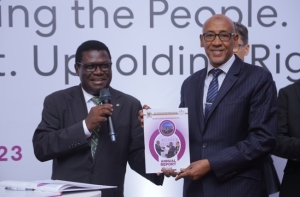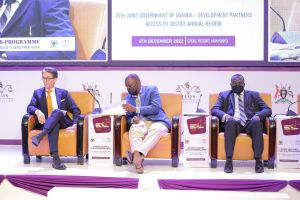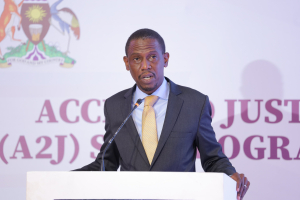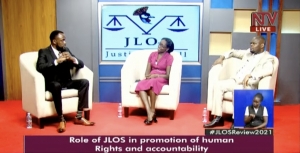Access to Justice (JLOS) Sub-programme performance report (FY 2022/23): Key Facts and Figures
December 01, 2023DOWNLOAD 2022/23 ANNUAL JLOS REPORT
- At the impact level, public trust in the justice system remains high compared to the SDPIV end-term evaluation and efforts to maintain it at higher levels are under implementation including addressing lead times for delivery of services, opening more service points, ensuring certainty in service delivery, and making use of online services.
- The sub-programme invested in the construction of justice centers increasing the number of districts with one-stop frontline JLOS points from 90 to 92 out of the targeted 117 districts.
- The Construction of the JLOS house phase one launched on 10th June 2022 is now over 60% and is expected to be completed in 2024.
- The sub-programme registered an increased disposal of cases from 52% in 2020 to 63% resulting in a 10% reduction in the proportion of backlog. Also, a 72% conviction rate was registered due to improved investigations and strong coordination. While the proportion of pretrial detained reduced to 48%
- The continued use of correctional approaches in the rehabilitation of inmates led to a 20% reduction in the rate of re-offending to 13.9% compared to the baseline of 17.2% in FY 2017/18.
- Public trust in the justice system is 69% according to data collected from the SEMA pilot program located at 50 frontline JLOS service points. Average satisfaction levels as measured by the SEMA applications at selected JLOS service points stand at 70%.
- During the reporting period, Pre-trial detainees reduced from 50.8% at the beginning of the financial year, to 48.5%. This is attributed to increased disposal of cases by the Judiciary, from 55% in FY 2021/22 to 63% in FY 2022/23. In addition, increased use of non-custodial punishment such as community service has reduced the inflow of convicted persons into prisons. For instance, the MIA was able to supervise a total number of 14,595 Community Service Orders (13,505 male, 1090 female) against an annual target of 14,000 orders representing 104.25%. Convicts sentenced to community service increased from 67.8% to 70% in the reporting period. However, the crime rate increased from 457.94 in FY 2021/22 to 524 in FY 2022/23 per 100,000 population.
- The CCTV surveillance project has revolutionized crime response and prevention with the system being operational (Phase II) in 71 districts, 10 cities, 20 municipalities, 35 towns, 06 border points and all major highways. The use of the Automated fingerprint Information system (AFIS) also helped to identify 3266 repeat offenders, while 219 people with criminal records seeking certificates of good conduct were identified.
- The plea bargain approach enabled the ODPP to deal with case backlog by fast-tracking cases, resulting in reduced case disposal time. It also improved the conviction rates since it offers 100% conviction rates.
- A total of 41 legal aid clinics run by JCU, ULS and LDC are fully operational and supported by JLOS. Those reached out to 141,347 vulnerable individuals and communities.
- Automation of Case management systems is ongoing in many institutions including the Judiciary, Uganda Registration Services Bureau (URSB), Directorate for Citizenship and Immigration Control (DCIC), National Identification and Registration Authority (NIRA), Office of the Director of Public Prosecutions (ODPP) and Judiciary. Other key areas of focus are streamlining processes, strengthening records management and reforming civil and business registries.
- The ODPP rolled out the Prosecution Case Management Information System (PROCAMIS) although it was slower than planned. The system has coverage of 42 (30%) out of 136 offices. The scope of automation covers headquarters, regional offices, and field stations.
- With regards to national identification and registration, which is a key driver for the improvement of service delivery in the country, cumulatively, a total of 16,749,675 cards have been issued to eligible citizens out of 19,761,668 cards printed.
- With regards to immigration, 12,354 work permits, 6,888 dependent passes, and 12,786 foreign students were facilitated. In addition, 7,030 people were granted special passes, 238,986 entry visas were issued, and 8,154 sought visitor pass extensions.
- During the reporting period, Anti-Corruption Agencies registered major progress in strengthening transparency, accountability, and anti-corruption systems. Conviction rates of corruption cases increased from 74% in 2017/18 to 82% in the reporting period due to the use of prosecution let investigation while the clearance rate of cases increased from 98% to 110% in the review period. This was because of the use of the interagency forum and stronger coordination and collaboration of the agencies involved in the fifth against crime.
- UHRC carried out inspections in 163 detention facilities including 86 Police stations, 31 Prisons, 41 Police posts, 3 remand homes and 2 military detention facilities. There were noticed improvements in living conditions, however, congestion remains an eye soar. To address this challenge, UPS constructed four (4) wards that increased the holding/ sleeping capacity from 19,986 prisoners (71,949.6M2) to 20,321 prisoners (73,155.6M2).
- The National Action Plan for Business and Human Rights is being implemented to mainstream human rights norms in the private sector. In addition, MoJCA mainstreamed the accepted recommendations from the third Universal Periodic Review into the National Action Plan for Human Rights (NAP). The NAP articulates human rights priority actions and interventions for implementation by both State and non-state actors.
- The program enhanced compliance with the bill of Rights, with the Uganda Human Rights Commission (UHRC) continuing to maintain an international ‘A’ status. UHRC conducted Tribunals across the nine (9) Regional offices. As a result, a total number of 143 matters were handled by the tribunal and complaints 93 (32 Male, 61 female) were resolved through mediation.
Challenges in the reporting period:
- The low staff numbers across the sub-programme institutions. Failure to address staffing has far-reaching implications and may reverse the gains made so far. This is made worse by the disproportionate recruitment in the judiciary as compared to other JLOS institutions.
- Increased prisoner population and Congestion in Prisons that exceeds carrying capacity by more than double. This may be addressed partly through expanding carrying capacity and crime prevention measures, in addition to focusing on alternative modes of punishment away from traditional incarceration. The increasing prison population puts pressure on housing, sanitation, medicare, feeding, uniforms, staff numbers and delivery of prisoners to courts.
- Inadequate facilitation of Attorneys and witnesses, affects the ability of the Government to be effectively represented in the courts of law for local and international cases.
Assessment of JLOS Performance (FY 2021/22) by Development Partners
December 06, 2022##
Assessment of JLOS Performance delivered by Mr. Nicolas Gonze on behalf of the JLOS Development Partners Group (DPG).
- My Lord, it is again, the time of the year for us jointly to take stock of the performance of the Access to Justice Sub-programme.
- It is my honour to deliver these assessments on behalf of the Access to Justice Development Partners Group. I would like to thank deeply and sincerely members of the group for the valuable contributions to the assessment, and their continued interest and dedication to the sub-programme.
- My Lord, the methodology of our assessment has remained the same as in the past. Before providing a highlight of our detailed comments and assessments, I would like to provide some general comments.
General Comments
- During the technical review on 25 November 2022, we had an in-depth and constructive discussions, and provided several recommendations on actions to improve the reporting.
- Overall, we note that there is a marked improvement in the quality of reporting compared to previous years. For this, we would like to acknowledge and greatly appreciate the valuable contributions of individuals and institutions who invested time and energy in the drafting of the report.
- I would also like to extend our appreciation to the Governance and Security Programme Secretariat for coordinating the drafting of the report, and for facilitating our cordial collaboration with Government.
I now turn to the highlights of our assessment of the performance during the period under review.
My Lord, under Outcome 1 on “People centred service delivery system strengthened”.
- We note that public trust in Access to Justice institutions is 9% above the target of 60%, which is commendable.
- We observe the launch of construction of the JLOS House, which when completed, when completed will be emblematic of the sub-programme’s endeavours to create peaceful and well-functioning society. So congratulations for the launch of the construction of the JLOS House.
- My Lord, although Judiciary is not part of this sub-programme, we would like to take this opportunity to recognise their efforts to improve the quality of state brief schemes to ensure that a person who cannot afford a private lawyer are represented effectively.
- We note that institutions have built capacity on management of GBV cases, but a witness protection law would be crucial for more progress.
- We positively note the UPF’s responses to the high prevalence of domestic violence including 7,000 SGBV investigations and training of trainers for handling of GBV cases and collecting evidence from crime scenes.
- The amendments to the Succession Act were eventually passed.
- My Lord, with conviction rates now over 70%, the Sub-programme is making significant progress. We recall a time when it was just slightly above 50%.
- We observe that community service is important and shows good results. In the reporting period, the Ministry of Internal Affairs supervised almost 17,000 community service orders, which is a significant contribution to case backlog reduction, the community and rehabilitation of offenders.
- However, as underlined by Ambassador Sadek in his speech, the DGF which has been supporting legal aid to more than 90,000 Ugandans is closing. It is not clear how the sub-programme will address this significant gap.
- It is worrisome that prison congestion levels increased from 323% to 351%. There is a need for a solid analysis of the main reasons for the congestion and why the remand population keeps growing.
- We observe with concerns that the proportion of magisterial areas accessing state funded legal aid is below 50%.
Overall, the assessment of Development Partners of Outcome 1 is “Satisfactory”.
My Lord, regarding Outcome 2 “JLOS Business Processes Reformed and Strengthened”
- We note that the targets for all (5) indicators were reported as met. These included case disposal rate of 55%, percentage of districts with one-stop front line service points at 83% and a conviction rate of 82% in corruption cases.
- We note with interest the conduct of normal sessions in the High Court during which 1,964 cases were concluded. We heard that regular hearing of criminal cases was being piloted at the high court leading to significant reduction in backlog. This is an issue we previously advocated for and would be pleased to hear more about.
- Other commendable achievements reported include:
- DPP consistently surpassing its quarterly targets of prosecutorial decisions;
- The country wide roll-out of small claims procedure, with a high number of and disputes resolved at the pre-trial stage;
- Broadly, a sizable number of cases were resolved through mediation with a success of 57%.
- Increased percentage of convicted prisoners from 46.5% to 49% during the period under review;
- My Lord, 206,000 cases, which accounted for 55% of the total caseload were disposed during the period under review. With the highest disposal rate of 71%, we would like to commend the efforts of lower courts in dispensing justice.
- In addition, we note further achievements including:
- The full adherence by UPS to production warrants;
- 171 cases won by the AG which saved GoU shs 424billion;
- DPP’s sanctioning of 56% of land cases and prosecution of 75% of cases against a target of 70%
- Furthermore, the target for level of automation of case management systems was exceeded and the target of JLOS Institutions with a functional M&E System was also achieved.
- However, we are concerned about the 11 months average length of stay on remand. We are also concerned that female suspects spend about 4 months more time on remand than male suspects.
- Also concerning is the worsening of average time taken to dispose cases from approximately 870 days in the previous reporting period to 930 days during the period under review.
- In addition, we note that budget cuts adversely affected operations of the DPP and late releases in quarter 1 further jeopardized their performance. UPF faced a similar funding challenge.
- My Lord, it is also worrying that the monthly average prison population now stands at 70,000 inmates, an increase of 0.7% from the previous reporting period.
- Finally, we analysed the case disposal and clearance rates at the Supreme Court and Court of Appeal and would like to respectfully urge for an internal reflection on how best to improve on the case disposal and clearance rates at these courts.
In view of the detailed comments above, the assessment of the performance under Outcome 2 is “Satisfactory”.
My Lord, regarding Outcome 3 on “Compliance with the Uganda Bill of Rights Strengthened”
- We note the launch of the National Action Plan on Business and Human Rights in October 2021 which is a significant achievement.
- In addition, we note the inspection of about 590 detention facilities across 9 regional offices by Uganda Human Rights Commission. In future, inclusion of the methodology of these inspections and how involved other mandated actors notably Justices of Peace are in inspecting places of detention would enrich the reporting.
- We note the outstanding performance of the Anti-Corruption Court Division (ACD) with a case clearance rate of 103%, a disposal rate of 51% - up from 48.5% registered in the previous reporting period, and, a conviction rate of 88%.
- My Lord, we note an interesting practice at the ACD, which limits the number of mentions and adjournments to only 3, after which active prosecution must start to avoid dismissal of a case. The practice can be instrumental in addressing case backlog, lengthy trial processes, unnecessary arrests or initiation of prosecution before investigations are complete.
- We note that except the indicator on increased capacity of policy makers and planners on HRBA, (5) out of the (6) performance indicators were not met. The indicators not achieved were: Proportion of human rights recommendations implemented, disposal rate of Human Rights cases, DPP’s conviction rate of corruption cases, and, proportion of citizens aware of the provisions of the bill of rights.
- Our view is that the finalisation of the National Action Plan on Human Rights has stagnated over the last couple of years.
- Also of concern, the inspection by UHRC revealed inadequate staffing at most police facilities coupled with a limited number of female police officers deployed at various police stations, and in particular in refugee hosting districts.
- We note with regret the reporting of continued detention of suspects beyond the 48 hours as stipulated in the Constitution. This is an issue we have consistently raised for several years and even before the COVID-19 pandemic and we encourage the government to take concrete action to address it.
- Regrettably, case clearance by UHRC was only 20% against a target of 76% and the proportion of decisions against JLOS institutions to total cases concluded by UHRC is unlikely to have been achieved.
- As highlighted by Ambassador Sadek in his intervention, torture and denial of personal liberty remain the most reported human rights violation over the years and the report states that the two topmost implicated institutions are UPF and UPDF.
- Another concern is the fact that the majority of 80% of trainees were men. The explanation provided in the report for this was neither clear nor convincing. There should be concerted effort to increase participation of women in trainings.
- Finally, we note lack of progress in the development of a law to provide for recovery of the proceeds of crime.
In light of these comments, the overall assessment of Development Partners of Outcome 3 was that limited progress was achieved.
- Therefore, in summary, 2 out of the 3 Outcomes were assessed as “Satisfactory” and 1 assessed as “Limited” progress.
- My Lord, these were the observations and assessment of the members of the Access to Justice Development Partners Group.
Thank you for your kind attention.
##
His Lordship the Honourable Chief Justice
Honourable Minister of Justice and Constitutional Affairs
Honourable Minister of Internal Affairs
Honourable Minister of Local Government
Honourable Attorney General
Honourable Minister of State for Internal Affairs
Honourable Justices and Judges of the Courts of Judicature
Director of Public Prosecutions
Excellencies Ambassadors and Heads of Diplomatic Missions present
Honourable Members of Parliament
Chairpersons of Constitutional Commissions
Solicitor General
Permanent Secretary – Ministry of Justice and Constitutional Affairs, Permanent Secretaries of Ministries present and Secretaries of Commissions present
Inspector General of Police
Commissioner General of Prisons
Representatives of Development Partners
Representatives of Civil Society
Ladies and Gentlemen
I am honoured to deliver these remarks on behalf of the Access to Justice Development Partners Group.
My Lord, today’s review is yet another valuable opportunity for us to jointly reflect on the performance of the Access to Justice Sub-programme in its mission to empower people, build trust and uphold rights.
When I took up my tour of duty recently, I was briefed on the good collaboration between the Access to Justice Development Partners Group and the Government, and its institutions over the years. Therefore, I convey our sincere gratefulness for the opportunity afforded to us to once again engage constructively.
My Lord, there were several significant achievements registered during the period under review and I now would like to highlight a few.
Building on progress in past years, there is now a one-stop frontline service point in 83% of the districts which is contributing to increased access to justice and satisfaction by the population.
In terms of infrastructure, the development partners would also like to laud the start of the construction of the JLOS house which will be a landmark building in Kampala, and which will lead to closer collaboration amongst the Access to Justice Sub-programme actors and ultimately improved service delivery to citizens.
We also positively note an increased percentage in case disposal rates, underpinned by disposal of a substantial number of cases especially in lower courts, and in the Anti-Corruption Court Division. Complementing these achievements was high conviction rates that demonstrated increased efficiency and competences at various phases of the criminal justice chain.
In addition, my Lord, we note the increased strengthening of business registries and the accelerated pace of automation of business processes within the Access to Justice Sub-programme institutions. The ability of the different systems to ‘speak’ and connect to each other will result in improved efficiency in the delivery of justice, law and order services thereby building more trust and confidence of users.
The report also highlights a significant drop in crime rates. We hope that this positive trend will continue.
I would like to turn now to some areas which deserve further discussions and efforts.
Although there are initiatives, the absence of a nationally funded legal aid scheme remains a significant impediment to access to justice, in particular for the poor and vulnerable persons. With the end of the Democratic Governance Facility that was providing legal aid to some 90,000 Ugandans, we would like to reiterate our previous calls for a nationally funded legal aid scheme to support access to justice and promote the right to a fair hearing enshrined in the Constitution.
As development partners, we would like to express our continued commitment to this important aspect of access to justice. In this regard, we would also like to stress the importance of the National Legal Aid Bill which we hope will be enacted soon.
My Lord, the annual report reveals that suspects spend a considerable period of time on remand, and that congestion in prisons and remand homes is acute – a situation that has been worsening in successive years. A concerted action and reforms are needed to address these challenges.
My Lord, distinguished guests, case backlog remains a significant issue. Although some gains are noted, the problem persists thereby eroding trust and impeding access to justice, law and order services. In particular, the Development Partners would like to renew their call for an expeditious disposal of backlogged cases, in particular a speedy trial of cases of sexual and gender-based violence and juvenile cases.
My Lord, I would like to make some observations on Outcome 3 which provides account of interventions undertaken to strengthen compliance with the bill of rights and tackle corruption within the Sub-programme institutions.
Progress on Outcome 3 has historically been the most mixed and this is the same for the period under review.
My Lord, as stated in the report, and I quote “Torture consistently remains the most reported human rights violation over the years, although with a declining numerical count compared to the baseline year 2016/17”[1]. The second most reported violation is denial of personal liberty. In this regard, we would like to call for perpetrators of human rights violations including those related to the November 2020 events to be held to account and ensure justice for victims. In addition, we would like to emphasise the urgency for finalisation and implementation of the National Action Plan on Human Rights, a process that in our view, has stalled.
We also note with concern reports about a resurgence of irregular arrests. We hope that implementation of the recent declaration of Honourable Minister of Internal Affairs to end arrests before investigations are complete will curb violations of the rights of suspects.
My Lord, and as I concluded, we would like to reiterate that the effective and close collaboration between the Access to Justice Sub-programme and the Administration of Justice Programme is essential. The participation of the leadership of both programmes in this review show your commitment to this collaboration.
With these remarks, I wish you fruitful deliberations during the course of the review.
Thank you for your kind attention!
##
Speech delivered at the 27th Annual JLOS Review on 6th December 2022 at Speke Resort Munyonyo, Kampala
[1] Access to Justice Sub-programme Annual Report 2021/2022, P.110
Speech by the Attorney General at the 27th Annual JLOS Review
December 06, 2022The Honourable Chief Justice of Uganda
Honourable Ministers
The Honourable Principal Judge
My Lords, Justices, and Judges of the Courts of Judicature
The Head of the European Union Delegation in Uganda and Chairperson of the Access to Justice Sub-Programme Development Partners’ Group
Your Excellencies, Heads of Diplomatic Missions to Uganda
Honourable Members of Parliament
Heads of Access to Justice Institutions
Members of the Steering and Technical Committees
Members of the District Chain Linked Committees
Distinguished invited guests in your respective capacities
Ladies and Gentlemen
It is my honour and privilege to welcome you all to this 27th edition of the Annual Access to Justice, Government of Uganda - Development Partners’ Review.
This year’s review is being held against a backdrop of a challenging year. The aftermath of the COVID 19 pandemic has globally been a challenging phenomenon – socially, economically, and politically. More specifically, the pandemic created unprecedented demands on the access to justice community but also tested the resilience and resolve of our coordination and collaborative model. I’m proud to note that in the face of such challenges, our decades-old coordination structures and mechanisms remained firm and intact.
Our review today is being held under the theme: “Empowering the People, Building Trust, Upholding Rights”. This theme is aligned to the National Vision 2040 that seeks to consolidate the principles of good governance including constitutional democracy, protection of human rights, the rule of law, Government effectiveness and citizen’s participation in development processes and peace and security among others. Indeed, Access to Justice Sub-Programme initiatives have been directed towards these results and the performance report that we will discuss today, will highlight the achievements made so far and the challenges ahead.
The evolving environment we operate is dynamic and there are high expectations from the public from access to justice service providers and duty bearers
The evolving environment we operate is dynamic and there are high expectations from the public from access to justice service providers and duty bearers. Cognizant of the fact that access to justice is a core pillar of our nation’s social economic transformation, we during the reporting year (2021/22) invested effort and resources in deconcentrating JLOS service delivery by reducing the distance people traverse in search of justice services; simplifying and streamlining business processes; improving customer experience and “justice journeys” at JLOS service points; empowering duty bearers in our institutions; tackling case management bottlenecks; and leveraging information and communication technologies (ICTs) to create new service delivery realities of efficiency and effectiveness.
However, challenges still abound. We need to find solutions to the ever-growing prison congestion; staffing gaps in frontline access to justice institutions; aspects of human rights violations; and the scarce financial resources allocated to the sub-programme – just to mention a few.
It's my hope that today, we shall have a meaningful and engaging discussion on the broad spectrum of all these issues that have direct and indirect impact on access to justice service delivery in our country.
I wish to welcome our friends from other programmes to this review. We are partners and comrades in this cause, and we look forward to renewed and strengthened inter-programme partnerships going forward.
I wish to welcome and thank our Development Partners for their unrelenting support over the years. We sincerely appreciate your unwavering commitment to the access to justice sub-programme going back twenty (20) years from the formative years of the Sector-wide approach.
Once again, thank you all for honouring our invitation and I look forward to your active participation in this Review.
##
Speech delivered at the 27th Annual JLOS Review on 6th December 2022 at Speke Resort Munyonyo, Kampala
#JLOSREVIEW2021: Promotion of Human Rights and Accountability
December 15, 2021FACTS AND FIGURES (HUMAN RIGHTS)
1) Observance of human rights across JLOS has continued to improve over the SDP IV period. This is attributed to increased establishment of human rights structures and mechanisms across different JLOS MDAs at national and sub-national levels, training of JLOS staff in human rights, and application of the standards in the administration of justice
2) In July 2021 H.E. the President appointed Ms. Mariam Wangadya as the new Chairperson of the Commission. She and five members of the Commission were sworn in on 30th September 2021 to commence work. The UHRC has nonetheless continued to maintain its ranking of “A” status.
3) Despite the COVID-19 disruption, the proportion or remand prisoners reduced from 52% in 2016 to an annual average of 50.6% in 2020/21. The lowest levels of 47.7% were reached in FY2018/19 as a result of increased case disposal.
4) The Sector, through the UHRC enhanced civic education using the media and dissemination of IEC materials, and this was complemented by the Electoral Commission and CSOs. The national election season was constrained by the COVID-19 pandemic and this limited the extent of physical association and citizen engagement
5) JLOS efforts to reduce human rights violations have broadly registered positive impact over the SDP IV period. The focus was largely on institutionalising human rights mechanisms within JLOS MDAs, building knowledge capacity amongst JLOS officers, enhancing monitoring inspection of key functions and processes, strengthening the legal and policy framework on human rights, and holding all persons involved in human rights violations accountable
6) In 2020/21, case clearance by UHRC was posited at 14.8% against a target of 76%. The UHRC concluded only 70 complaints through mediation because its tribunal was non-functional for the entire year. Currently, the UHRC is fully constituted and all mechanisms are functional.
7) JLOS has maintained human rights structures and mechanisms in key institutions, including the UPF’s Directorate of Human Rights and Legal Services established in 2015, Human Rights Desks in all 28 police regions, Human Rights Committees in all 259 prison units across the country, and human rights desks in key MDAs including ODPP, and MoJCA
8) At the institutional level, JLOS continued to support its human rights mechanisms and ensure their functionality, and established new ones as well. The focus has largely been on the criminal justice chain where human rights violations were observed and reported by members of the public
FACTS AND FIGURES (ACCOUNTABILITY)
1) Since 2016/17, the perception index against corruption has improved from 25% in 2016 to 27% in 2020/21
2) The fight against corruption was strengthened through increased capacity building and enforcement of anti-corruption laws, combined with a heightened focus on asset recovery
3) The Anti-corruption Division (ACD) of the High Court is one of the anti-corruption hallmarks of achievement of JLOS over the 20-year period. Established in 2009, the ACD has emerged as a leading mechanism in the fight against corruption in Uganda, and a benchmark for the African region.
4) During the SDP IV implementation period, the ACD case clearance rate has increased by a proportion of 30%, from a rating of 89% in 2016/17 to 115.6% in 2020/21. Over the same period, the ACD disposal rate has grown by 15.5%.
5) Uganda’s ranking under the Transparency International’s Corruption Perception Index (CPI) score also dropped from 28% to 27%. Uganda’s international rank also dropped from 137th to 142nd of 180 countries assessed. This is largely attributed to the prevailing apathy where the public is complicit in the growing levels of corruption in Uganda
Adopted from the JLOS Annual Report (2020 - 2021)
NEWSROOM
Latest News
Privacy Policy
News Archives







